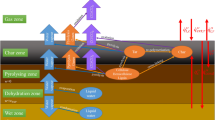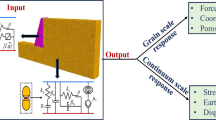Abstract
The transverse compression behavior of Douglas-fir wood (Pseudotsuga menziesii) at high temperature (170 °C) and saturated steam conditions was studied and compared with previously reported compression behavior of hybrid poplar (Populus deltoides × Populus trichocarpa). The effect of the compression on the stress–strain response, non-linear strain function, and relative density change was examined by a modified Hooke’s law based on the load-compression behavior of flexible foams. Transverse compressive loading followed a typical stress–strain curve of wood. The compressive modulus of Douglas-fir was higher than hybrid poplar. The yield stress of Douglas-fir specimens was higher than yield stress of hybrid poplar specimens, while densification stress of both wood species was the same. The comparison of the non-linear strain function of Douglas-fir and hybrid poplar specimens revealed significant differences. The observed differences are assumed to be due to different cellular structure and chemical composition of softwoods versus hardwoods.
Zusammenfassung
In dieser Studie wurde das Querdruckverhalten von Douglasienholz (Pseudotsuga menziesii) bei hoher Temperatur (170 °C) und unter Sattdampfbedingungen untersucht und mit dem früher untersuchtem Querdruckverhalten der Hybridpappel (Populus deltoides × Populus trichocarpa) verglichen. Der Einfluss des Drucks auf das Spannungs-Stauchungs-Verhalten, die nichtlineare Dehnungsfunktion und die relative Dichteänderung wurde mittels eines modifizierten Hookeschen Gesetzes basierend auf dem Verformungsverhalten von Weichschaumstoffen untersucht. Die Querdruckbelastung folgte dem typischen Verlauf eines Spannungs-Stauchungs-Diagramms von Holz. Der Druckmodul von Douglasie war höher als der von Hybridpappel. Die Fließgrenze von Douglasienprüfkörpern war höher als die von Hybridpappelprüfkörpern, wohingegen die Spannung an der Verdichtungsgrenze bei beiden Holzarten gleich war. Die nichtlineare Dehnungsfunktion von Douglasien- und Hybridpappelprüfkörpern unterschied sich signifikant. Es wird angenommen, dass die Gründe für diese Unterschiede in der unterschiedlichen Zellstruktur und der chemischen Zusammensetzung von Nadelholz und Laubholz liegen.






Similar content being viewed by others
References
Balatinecz JJ, Kretschmann DE (2001): Poplar culture in North America, Chapter 9, Properties and utilization of poplar wood. In: Dickmann DI, Isebrands JG, Eckenwalder JE, Richardson J (eds), NRC Research Press, Ottawa
Barnett JR, Bonham VA (2004) Cellulose microfibril angle in the cell wall of wood fibers. Biol Rev 79:461–472
Bodig J (1963) The peculiarity of compression of conifers in radial direction. For Prod J 13:438
Bodig J (1965) The effect of anatomy on the initial stress-strain relationship in transverse compression. For Prod J 15:197–202
Bodig J, Jayne BA (1982) Mechanics of wood and wood composites. Van Nostran-Reinhold Co, Inc., New York, p 711
Clair B (2010) Maturation stress in developing tension wood. Plant Physiol 155(1):562–570
Dadswell HE, Hawley LF (1929) Chemical composition of wood in relation to physical characteristics. A preliminary study. Indust Eng Chem 21:973–975
Dai C (2001) Viscoelasticity of wood composite mats during consolidation. Wood Fiber Sci 33(3):353–363
Dai C, Steiner PR (1993) Compression behavior of randomly formed wood flake mats. Wood Fiber Sci 25(4):349–358
Dinwoodie JM (2000) Timber. Its nature and behavior. BRE, London and New York
Ellis S, Steiner P (2002) The behavior of five wood species in compression. IAWA J 23(2):201–211
Fang CH, Guibal D, Clair B, Gril J, Liu YM, Liu SQ (2008) Relationships between growth stress and wood properties in poplar I-69 (Populous deltoides Bartr.cv. “Lux” ex I-69/55). Ann For Sci 65(3):307
Gibson LJ, Ashby MF (1988) Cellular solids structure and properties. Pergamon press, Oxford, p 357
Hillis WE, Rozsa AN (1978) The softening temperatures of wood. Holzforschung 32(2):68–73
Kamke FA, Kutnar A (2010) Transverse compression behavior of wood in saturated steam at 150 to 170° C. Wood Fiber Sci 42(3):1–11
Kärenlampi PP, Tynjälä P, Ström P (2003) Effect of temperature and compression on the mechanical behavior of steam-treated wood. J Wood Sci 49:298–304
Kennedy RW (1968) Wood in transverse compression. For Prod J 18:36–40
Klasnja B, Kopitovic S, Orlovic S (2003) Variability of some wood properties of eastern cottonwood (Populus deltoides Bartr.) clones. Wood Sci Technol 37:331–337
Kunesh RH (1961) The inelastic behavior of wood: a new concept for improved panel forming processes. For Prod J 11:395–406
Lang EM, Wolcott MP (1996) A model for viscoelastic consolidation of wood-strand mats. Part II: static stress–strain behaviour of the mat. Wood Fiber Sci 28(3):369–379
Lenth CA, Kamke FA (1996) Investigations of flakeboard mat consolidation. Part I. characterizing the cellular structure. Wood Fiber Sci 28(2):153–167
Nairn JA (2006) Numerical simulations of transverse compression and densification in wood. Wood Fiber Sci 38(4):576–591
Östberg G, Salmen L, Terlecki J (1990) Softening temperature of moist wood measured by differential calorimetry. Holzforschung 44:223–225
Placet V, Passard J, Perré P (2007) Viscoelastic properties of green wood across the grain measured by harmonic tests in the range 0–95°C: hardwood vs. softwood and normal wood vs. reaction wood. Holzforschung 61:548–557
Reiterer A, Stanzl-Tschegg SE (2001) Compressive behavior of softwood under uniaxial loading at different orientations to the grain. Mech Mat 33:705–715
Ribeiro HA, Costa CAV (2007) Modeling and simulation of the nonlinear behavior of paper: a cellular materials approach. Chem Eng Sci 62:6696–6708
Sadoh T (1981) Viscoelastic properties of wood in swelling systems. Wood Sci Technol 15:57–66
Tabarsa T (1999): Compression perpendicular-to-grain behavior of wood. PhD Dissertation, The University of New Brunswick, Canada, pp 243
Tabarsa T, Chui YH (2000) Stress–strain response of wood under radial compression. Part I. Test method and influences of cellular properties. Wood Fiber Sci 32(2):144–152
Uhmeier A, Morooka T, Norimoto M (1998) Influence of thermal softening and degradation on radial compression behavior of wet spruce. Holzforschung 52(1):77–81
Wang JY, Cooper PA (2005) Effect of grain orientation and surface wetting on vertical density profiles of thermally compressed fir and spruce. Holz Roh- Werkst 63:397–402
Winandy JE, Morrell JJ (1993) Relationship between incipient decay, strength, and chemical composition of Douglas-fir heartwood. Wood Fiber Sci 25(3):278–288
Wolcott MP (1989): Modelling viscoelastic cellular materials for the pressing of wood composites. PhD Dissertation, Virginia Tech, Blacksburg, Virginia, pp 182
Wolcott MP, Kamke FA, Dillard DA (1994) Fundamental aspects of wood deformation pertaining to manufacture of wood-base composites. Wood Fiber Sci 26(4):496–511
Xu P, Liu H (2004) Models of microfibril elastic modulus parallel to the cell axis. Wood Sci Technol 38:363–374
Zhou C, Smith GD, Dai C (2009) Characterizing hydro-thermal compression behavior of aspen wood strands. Holzforschung 63(5):609–617
Acknowledgments
The project was supported by the National Research Initiative of the USDA Cooperative State Research, Education and Extension Service, grant number 2006-35504-17444 and USDA Wood Utilization Research Center Special Grant number 2008-34158-19302.
Author information
Authors and Affiliations
Corresponding author
Rights and permissions
About this article
Cite this article
Kutnar, A., Kamke, F.A. Transverse compression behavior of Douglas-fir (Pseudotsuga menziesii) in saturated steam environment. Eur. J. Wood Prod. 71, 443–449 (2013). https://doi.org/10.1007/s00107-013-0698-z
Received:
Published:
Issue Date:
DOI: https://doi.org/10.1007/s00107-013-0698-z




